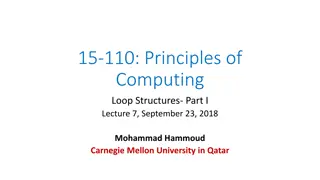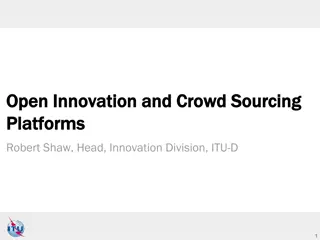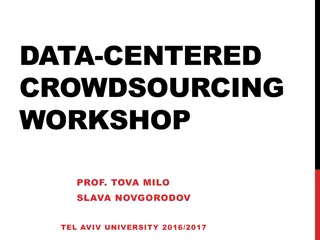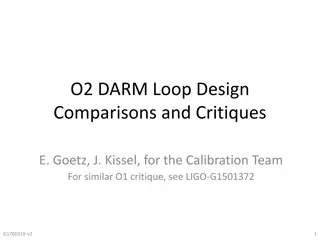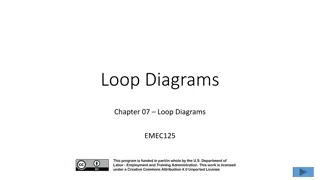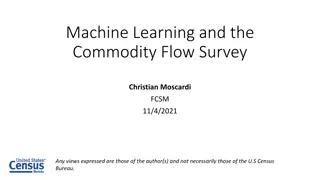Human-in-the-Loop CrowdDB: Crowdsourcing for Database Extension
The presentation discusses leveraging human resources to enhance relational database systems through CrowdDB. It explores the integration of human computation with SQL semantics to tackle subjective comparisons and ambiguous queries. Additionally, the use of platforms like Amazon Mechanical Turk for crowdsourcing tasks is highlighted. The design considerations, performance, variability, and benefits of employing crowdsourcing in database tasks are also covered. CrowdDB streamlines the process of issuing requests using CrowdSQL and storing crowd-obtained results in databases for future usage.
Download Presentation

Please find below an Image/Link to download the presentation.
The content on the website is provided AS IS for your information and personal use only. It may not be sold, licensed, or shared on other websites without obtaining consent from the author.If you encounter any issues during the download, it is possible that the publisher has removed the file from their server.
You are allowed to download the files provided on this website for personal or commercial use, subject to the condition that they are used lawfully. All files are the property of their respective owners.
The content on the website is provided AS IS for your information and personal use only. It may not be sold, licensed, or shared on other websites without obtaining consent from the author.
E N D
Presentation Transcript
1 Human in the Loop CrowdDB: Answering Queries With Crowdsourcing Presented by: Fareedah ALSaad
2 Human in the Loop Motivation Relational database systems are based on the Closed World Assumption . Relational databases are extremely literal. SELECT market_capitalization FROM company WHERE name = "I.B.M."; Entity Resolution Problem RDMS cannot deal with subjective comparison. How to leverage human resources to extend the capabilities of database systems?
3 Human in the Loop Motivation Develop CrowdDB: A relational query processing system maintain SQL semantics. Rely on traditional RDBS to do the heavy lifting data manipulation. Extend SQL to enable queries that involve human computation.
4 Human in the Loop Crowdsourcing Platform Amazon Mechanical Turk (AMT). AMT basics: HIT (Human Intelligent Task): Smallest entity of work one or more job, e.g. tagging 5 pictures. Assignment: A HIT is replicated into multiple assignments for majority votes. HIT Group: A group of similar HITs.
5 Human in the Loop Crowdsourcing Platform Amazon Mechanical Turk (AMT). AMT APIs: createHIT(title, description, question, keywords, reward, duration, maxAssignments, lifetime) HitID getAssignmentsForHIT(HitID) list(asnId, workerId , answer) approveAssignment(asnID) rejectAssignment(asnID) forceExpireHIT(HitID)
6 Human in the Loop CrowdDB Design Considerations Performance and Variability: People and machines differ in speed, cost, and quality. People show tremendous variability. Task Design and Ambiguity: Ambiguities due to natural language. Interface design can affect the accuracy and the speed. Affinity and Learning: Crowd workers develop relationships with requesters and skills for certain HIT types. Relatively Small Worker Pool. Open vs. Closed World.
7 Human in the Loop Overview of CrowdDB An application issues requests using CrowdSQL. The complexities of dealing with the crowd are encapsulated by CrowdDB. Results obtained from the crowd can be stored in the database for future use.
8 Human in the Loop CrowdSQL Incomplete Data Use special keyword: CROWD. Incomplete data can occur in two flavors: Crowdsourced Column: CREATE TABLE Department ( university STRING, name STRING, url CROWD STRING, phone STRING, PRIMARY KEY (university, name) ); 1. Crowdsourced Table: CREATE CROWD TABLE Professor ( name STRING PRIMARY KEY, email STRING UNIQUE, university STRING, department STRING, FOREIGN KEY (university, department) REF Department(university, name) ); 2.
9 Human in the Loop CrowdSQL Incomplete Data Use new value type CNULL to indicates that a value should be crowdsourced when it is first used . CNULL is the default value of any CROWD column. CNULL values are generated as a side-effect of INSERT statements: INSERT INTO Department(university, name) VALUES ("UC Berkeley", "EECS"); university UC Berkeley name EECS url phone NULL CNULL
10 Human in the Loop CrowdSQL Incomplete Data Use new value type CNULL to indicates that a value should be crowdsourced when it is first used . CNULL is the default value of any CROWD column. CNULL values are generated as a side-effect of INSERT statements: INSERT INTO Department(university, name) VALUES ("UC Berkeley", "EECS"); Allow crowdsourcing as a side-effect of query processing: SELECT url FROM Department WHERE name = "Math";
11 Human in the Loop CrowdSQL Subjective Comparisons Use two new built in functions: CROWDEQUAL,CROWDORDER. 1. CROWDEQUAL (~=) 1. CROWDORDER SELECT profile FROM department WHERE name ~= "CS"; CREATE TABLE picture ( p IMAGE, subject STRING); SELECT p FROM picture WHERE subject = "Golden Gate Bridge" ORDER BY CROWDORDER(p, "Which picture visualizes better %subject");
12 Human in the Loop CrowdSQL in Practice Practical issues that limit the usage of CrowdSQL: 1. Cost and response time of queries can be unbounded. 2. Lineage: track source of data to take actions. 3. Cleansing of crowdsourced data entity resolution.
13 Human in the Loop User Interface Generation Automatically generates user interfaces for incomplete information and subjective comparisons. Create templates at a compile-time. Templates are instantiated at a run-time for each tuple. Templates can be edited for customized instruction.
14 Human in the Loop User Interface Generation Basic Interface: Two types of optimization: 1. Batch several tuples. 2. Prefetching of attributes of the same tuple.
15 Human in the Loop User Interface Generation Multi-relational interface: Foreign-key references a non-crowdsourced table: A drop-down box of possible foreign keys. Ajax-based suggest function. Foreign-key references a crowdsourced table: Normalized interface suggest function can be used to avoid entity resolution problem. Denormalized interface.
16 Human in the Loop Query Processing Crowd Operators Three crowd operators: 1. CrowdProbe: Crowdsources missing information of CROWD and new tuples. 2. CrowdJoin: At least one table is a crowdsourced table. 3. CrowdCompare: Implement the CROWDEQUAL and CROWDORDER function. Quality control is carried out by a majority vote.
17 Human in the Loop Query Processing Physical Plan Generation Heuristics: Simple rule-based optimizer: e.g. predicate push-down. Crowdsourcing rules: Set the basic crowdsourcing parameters (price, batching-size). Select the user interface (normalized vs. denormalized). A cost-based optimize that considers the changing conditions on AMT, remains future work.
18 Human in the Loop Experiments and Results Simple Queries Response Time, Vary HIT Group SELECT phone_number, address FROM businesses; Within 30 min
19 Human in the Loop Experiments and Results Simple Queries Responsiveness, Vary Rewards
20 Human in the Loop Experiments and Results Simple Queries Worker Affinity and Quality
21 Human in the Loop Experiments and Results Complex Queries Entities Resolution on Companies SELECT name FROM company WHERE name~="[a non-uniform name of the company]"
22 Human in the Loop Experiments and Results Complex Queries Ordering Pictures {# of votes by the workers, picture rank based on workers votes, picture rank ordered by experts}
23 Human in the Loop Experiments and Results Complex Queries Joining Professors and Departments SELECT p.name, p.email, d.name, d.phone FROM Professor p, Department d WHERE p.department = d.name AND p.university = d.university AND p.name = "[name of a professor]" Compare the performance of two plans: Two steps: collect professor information and then the department information. A single step: collect professor and department information together use denormalized interface Two plans were similar in execution time and cost. First plan (two steps) has better accuracy. 1. 2. In the second plan, workers submitted the professors phone numbers instead of the departments.
24 Human in the Loop Observations Challenges in controlling the factors that impact response time, cost and result quality. Crowd resources involve long-term memory that can impact performance Keep workers happy. User interface design and precise instructions matter a good interface improves result quality and worker efficiency.
25 Human in the Loop Related Work Database Systems: Leverages traditional techniques for relational query processing. Top N optimizations to deal with the open-world nature of crowdsourcing. The volatility of crowd performance needs adaptive query processing techniques. Automatic generation of user interfaces similar to Oracle Forms. Crowdsourcing Communities: Ipeirotis analyzed the AMT marketplace by gathering some statistics. CrowdSearch attempts to automatically control quality and optimize response time. TurKit is a set of tools that enables programming iterative algorithms over the crowd. Quark and (Parameswaran and Polyzotis, 2011): explore the use of crowdsourcing in relational query processing.
26 Human in the Loop Thank You







